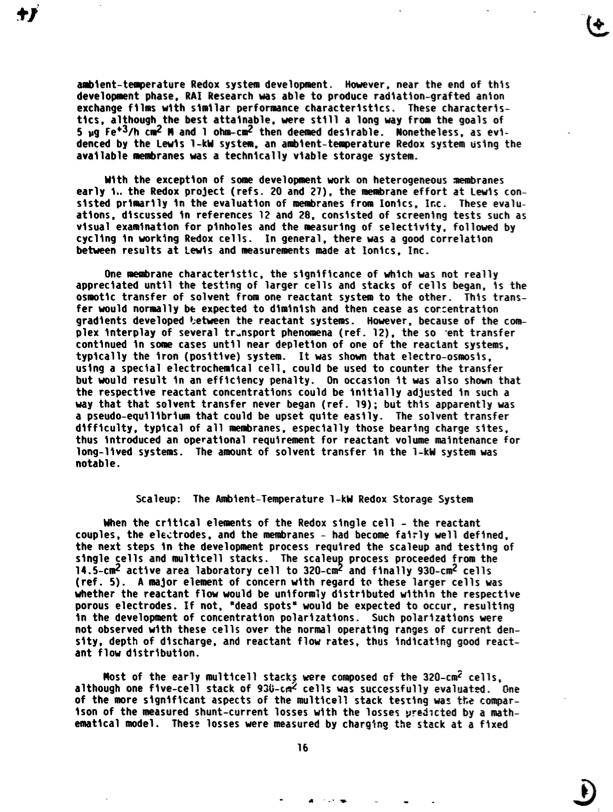
PDF Publication Title:
Text from PDF Page: 019
-lent-tqerature Redox system development. However, near the end of this development phase, RAI Research was able t o produce radiation-grafted anion exchange films with slmilar performance characteristics. These characteris- tics, although the best attainable. were s t i l l a long way from the goals of 5 pg ~e+3/hc d I4 and 1 ohm-cd then deemed desirable. #onetheless, as evi- denced by the Lewis l-kW system, an aiebient-tewperature Redox system using the available nmbranes was a technically viable storage system. With the exception of some development work on heterogeneous aembranes early 1,. the Redox project (refs. 20 and 27), the membrane effort at Lewis con- sisted prllaarlly i n the evaluation of membranes from Ionics, Icc. These evalu- ations, discussed i n references 12 and 28, consisted of screening tests such as visual examination for pinholes and the measuring of selectivity, followed by cycling i n working Rrtdox cells. I n general, there was a good correlation between results a t Lewis and measurements made a t lonics, Inc. One membrane characteristic, the significance of whlch was not really appreciated until the testlng of larger cells and stacks of cells began, is the osmotic transfer of solvent from one reactant system t o the other. This trans- fer would normally be expected to diminish and then cease as coctentration gradients developed between the reactant systems. However, because of the corn- plex interplay of several tr-nsport phenomena (ref. 12). the so -ent transfer continued i n some cases u n t i l near depletion of one of the reactant systems, typically the iron (positive) system. It was shown that electro-osmosis, using a special electrochemical cell, could be used to counter the transfer butwouldresultinanefficiencypenalty. Onoccasionitwasalsoshownthat the respective reactant concentrations could be i n i t i a l l y adjested i n such a way that that solvent transfer never began (ref. 19); but this apparently was a pseudo-equilibrium that could be upset quite easily. The solvent transfer difficulty, typical of all membranes, especially those bearing charge sites, thus introduced an operational requirement for reactant volume maintenance for long-lived systems. The amount of solvent transfer i n the 1-kW system was notable. Scaleup: The Ambient-Temperature 1-kW Redox Storage System When the critical elements of the Redox single cell - the reactant couples, the electrodes, and the membranes - had become f a l i l y well defined, the next steps in the development process required the scaleup and testing of single cells and multicell stacks. The scaleu process proceeded from the 14.5-cd active area laboratory cell to 320-cmPand finally 930-cm2 cells (ref. 5). A major element of concern with regard t o these larger cells was whether the reactant flow would be uniformly distributed within the respective porous electrodes. I f not, "dead spotsmwould be expected t o occur, resulting i n the development of concentration polarizations . Such polarizatlons were not observed with these cells over the normal operating ranges of current den- sity, depth of discharge, and reactant flow rates, thus fndlcat!ng good react- ant flow distrlbutlon. Most of the early rnulticell stack; were composed of the 320-cmi cells, although one five-cell stack of 93b-end cells was successfully evaluated. One of the more slgniflcant aspects of the multicell stack testing wa5 the compar- ison of the measured shunt-current losses wlth the lossen yredlcted by a math- emtical model. These losses were measured by charg'rng the stack at a fixedPDF Image | NASA Redox Storage System Development Project

PDF Search Title:
NASA Redox Storage System Development ProjectOriginal File Name Searched:
19850004157.pdfDIY PDF Search: Google It | Yahoo | Bing
CO2 Organic Rankine Cycle Experimenter Platform The supercritical CO2 phase change system is both a heat pump and organic rankine cycle which can be used for those purposes and as a supercritical extractor for advanced subcritical and supercritical extraction technology. Uses include producing nanoparticles, precious metal CO2 extraction, lithium battery recycling, and other applications... More Info
Heat Pumps CO2 ORC Heat Pump System Platform More Info
| CONTACT TEL: 608-238-6001 Email: greg@infinityturbine.com | RSS | AMP |